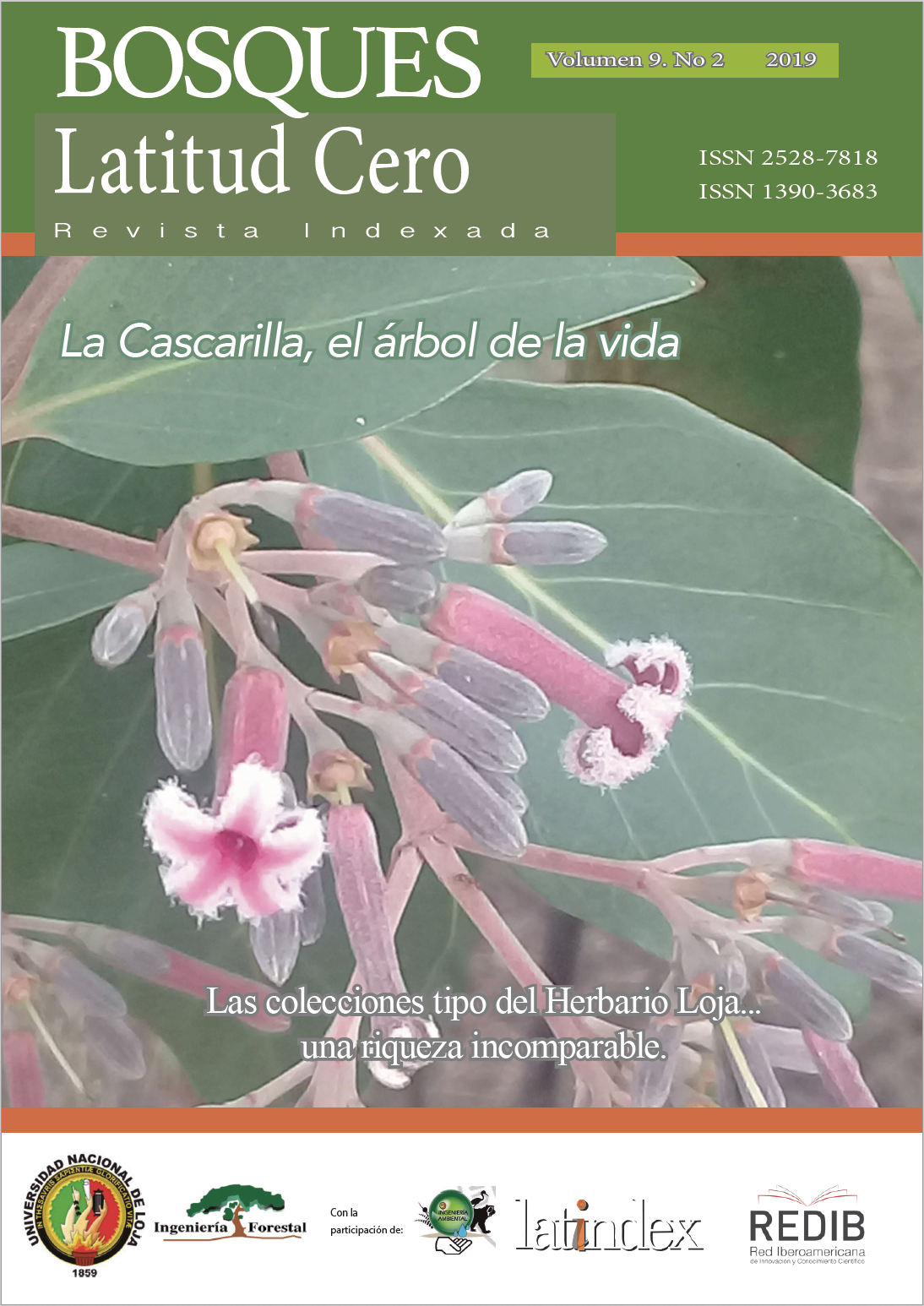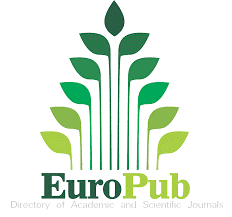Páramos del Ecuador, importancia y afectaciones: Una revisión
Palabras clave:
páramo, Ecuador, importancia, afectacionesResumen
Los páramos son ecosistemas frágiles neotropicales de alta montaña. En Ecuador tienen una altura promedio de 3300 m s.n.m., y cubre el 7 % de su territorio, y proveen servicios ecosistémicos como: recursos hídricos de calidad y sumideros de carbono principalmente. Sus suelos con densidad aparente baja, estructura abierta y porosa posibilitan retención de agua y conductividad hidráulica altas, donde se desarrollan plantas endémicas y diversidad faunística. Estos ecosistemas tienen además importancia social y cultural, en ellos viven una población marginada, sin embargo, genera recursos económicos con la producción diversa de alimentos agrícolas y la gestión del turismo y la recreación; lamentablemente están afectados por el cambio de uso del suelo, introducción de plantas exóticas, incendios, cambio climático y en algunos sectores por la actividad minera. El principal objetivo de la revisión bibliográfica fue conocer la importancia y las afectaciones que tienen los páramos. Para ello, se utilizaron las bases de datos de la Web of Science y Elsevier’s Scopus durante un periodo de 23 años. El término de búsqueda fue: “páramos ecuador”. De esta revisión se concluye que los páramos son de vital importancia para la regulación del clima, ciclo hidrológico y el desarrollo económico, social y cultural de la población; además, tienen importancia biológica, y capacidad para almacenar y regular agua.Citas
Avellaneda, Lizeth Manuela, Tomás Enrique, León Sicard, and Esperanza Torres. 2018. “Impact of Potato Cultivation and Cattle Farming on Physicochemical Parameters and Enzymatic Activities of Neotropical High Andean Páramo Ecosystem Soils.” Science of the Total Environment 631–632: 1600–1610. https://doi.org/10.1016/j.scitotenv.2018.03.137.
Beltrán, K, S. Salgado, F. Cuesta, S. León, K. Romoleroux, E. Ortiz, A. Cárdenas, and Alexandra Velástegui. (2009). “Sistemas Ecológicos y Caracterización Florística de Los Páramos En El Ecuador.” Quito.
Buytaer, W., F. Cuesta, and F. Tobón. (2011). “Regions, Potential Impacts of Climate Change on the Environmental Services of Humid Tropical Alpine.” Global Ecology and Biogeography 20: 19–33.
Buytaert, W., R. Célleri, B. De Biévre, and F. Cisneros. (2014). “HIDROLOGÍA DEL PÁRAMO ANDINO: PROPIEDADES, IMPORTANCIA Y VULNERABILIDAD.”
Buytaert, W., V. Iñiguez, and B. De Biévre. (2007). “The Effects of Afforestation and Cultivation on Water Yield in the Andean Paramo.” Foresta Ecology and Management 251: 22–30. https://doi.org/10.1016/j.foreco.2007.06.035.
Buytaert, W., J. Sevink, B. Leeuw, and J. Deckers. (2005). “Clay Mineralogy of the Soils in the South Ecuadorian Paramo Region.” Geoderma 127: 114–29. https://doi.org/10.1016/j.geoderma.2004.11.021.
Buytaert, W., G. Wyseure, B. De Bievre, and J. Deckers. (2005). “The Effect of Land-Use Changes on the Hydrological Behaviour of Histic Andosols in South Ecuador.” Hydrological Processes 19 (January 2004): 3985–97. https://doi.org/10.1002/hyp.5867.
Buytaert, Wouter, Rolando Célleri, Bert De Bièvre, Felipe Cisneros, Guido Wyseure, Jozef Deckers, and Robert Hofstede. (2006). “Human Impact on the Hydrology of the Andean Páramos.” Environmental Sciences 79: 53–72. https://doi.org/10.1016/j.earscirev.2006.06.002.
Caranqui, J., P. Lozano, and J Reyes. (2016). “Composición y Diversidad Florística de Los Páramos En La Reserva de Producción de Fauna Chimborazo, Ecuador.” Riobamba.
Carrillo, Galo, Brenner Silva, Rütger Rollenbeck, Rolando Célleri, and Jörg Bendix. (2019). “The Breathing of the Andean Highlands : Net Ecosystem Exchange and Evapotranspiration over the Páramo of Southern Ecuador.” Agricultural and Forest Meteorology 265 (March 2018): 30–47. https://doi.org/10.1016/j.agrformet.2018.11.006.
Córdoba, M., Galo Carrillo, Patricio Crespo, and Bradford P Wilcox. (2015). “Evaluation of the Penman-Monteith (FAO 56 PM) Method for Calculating Reference Evapotranspiration Using Limited Data. Application to the Wet Páramo of Southern Ecuador.” International Mountain Society 3 (August): 230–39. https://doi.org/10.1659/MRD-JOURNAL-D-14-0024.1.
Cuesta, F., and B. De Bièvre. (2008). “Páramo of Northern Andes (Venezuela, Colombia, Ecuador, Northern Perú). Temperate Grasslands of South America.”
Engler, R., C. Randin, W. Thuiller, S. Dullinger, N. Zimmermannk, M. Araújo, P. Pearman, et al. (2011). “21st Century Climate Change Threatens Mountain Flora Unequally across Europe.” Global Change Biology 17: 2330–41. https://doi.org/10.1111/j.1365-2486.2010.02393.x.
Farley, Kathleen A, and Eugene F Kelly. (2004). “Effects of Afforestation of a Páramo Grassland on Soil Nutrient Status Kathleen.” Forest Ecology and Management 195: 281–90. https://doi.org/10.1016/j.foreco.2003.12.015.
Groot, Rudolf S De, Matthew A Wilson, and Roelof M J Boumans. (2002). “A Typology for the Classification , Description and Valuation of Ecosystem Functions , Goods and Services.” Ecological Economics 41: 393–408.
Hofstede, R., J. Calles, V. López, R. Polanco, F. Torres, J. Ulloa, A. Vásquez, M. Cerra, and Revisión. (2014). Los Páramos Andinos ¿Qué Sabemos? Quito: Unión Internacional para la Conservación de la Naturaleza y de los Recursos Naturales.
Hofstede, R., R. Coppus, P. Vásconez, P. Segarra, and J. Wolf. (2002). “The Conservation Status of Tussock Grass Paramo in Ecuador.” Ecotropicos 15 (January): 3–18.
Hofstede, R., J. Groenendijk, R. Coppus, J. Fehse, and J. Sevink. (2002). “Impact of Pine Plantations on Soils and Vegetation in the Ecuadorian High Andesr.” Mountain Res. Dev. 22: 159–76.
Hofstede, R., and L. Llambí. (2019). Plant Diversity in Páramo—Neotropical High Mountain Humid Grasslands. Earth Systems and Environmental Sciences. Elsevier. https://doi.org/doi.org/10.1016/B978-0-12-409548-9.11858-5.
Hofstede, R., and P. Mena. (2000). “Los Beneficios Escodidos Del Páramos: Servicios Ecológicos e Impacto Humano.” In II Conferencia Electrónica Sobre Usos Sostenibles y Conservación Del Ecosistema Páramo En Los Andes: “Los Páramos Como Fuente de Agua, Mitos, Realidades, Retos y Acciones,” edited by COSUDE, 58. Universidad de Amsterdam.
IPCC. (2007). “Climate Change 2007: Impacts, Adaptation and Vulnerability. Contribution of Working Group II to the Fourth Assessment Report of the Intergovermental Panel on Climate Change.” UK.
———. (2014). Climate Change 2014: Impacts, Adaptation, and Vulnerability. Part A: Global and Sectoral Aspects. Contribution of Working Group II to the Fifth Assessment Report of the Intergovernmental Panel on Climate Change. Edited by and L.L. White C.B., V.R. Barros, D.J. Dokken, K.J. Mach, M.D. Mastrandrea, T.E. Bilir, M. Chatterjee, K.L. Ebi, Y.O. Estrada, R.C. Genova, B. Girma, E.S. Kissel, A.N. Levy, S. MacCracken, P.R. Mastrandrea. Cambridge, United Kingdom and New York, NY, USA: Cambridge University Press.
Josse, C., P. Mena, and G. Medina. (2000). “La Biodiversidad de Los Páramos.”
Kehrer, W., and G. der Kaaden. 1979. “Notes on the Geology of Ecuador with Special Reference to the Western Cordillera.”
Kuhn, Rosie. (2011). “No Todo Lo Que Brilla Es Oro Conflictos Socio Ambientales Alrededor de Dos Proyectos de Minería a Gran Escala En El Ecuador.” Universidad Andina Simón Bolívar Sede.
Lazo, Patricio X, Giovanny M Mosquera, Jeffrey J Mcdonnell, and Patricio Crespo. (2019). “The Role of Vegetation, Soils, and Precipitation on Water Storage and Hydrological Services in Andean Páramo Catchments.” Journal of Hydrology. https://doi.org/10.1016/j.jhydrol.2019.03.050.
Llambí, L., A. Soto, R. Célleri, B. De Bièvre, B. Ochoa, and P. Borja. (2012). “Ecología, Hidrología y Suelos de Páramos, Proyecto Páramo Andino.” Quito, Ecuador.
López, S., C. Wright, and P. Costanza. (2016). “Environmental Change in the Equatorial Andes: Linking Climate, Land Use, and Land Cover Transformations.” Remote Sensing Applications: Society and Environment. https://doi.org/10.1016/j.rsase.2016.11.001.
Macas, B. (2019). Políticas enticampesinas y minería como amenaza a la soberanía alimentaria en el Sur del ecuador. CRIALZCH, (2): 68-77
Madriñán, Santiago, Andrés J Cortés, and James E Richardson. (2013). “Páramo Is the World’s Fastest Evolving and Coolest Biodiversity Hotspot” 4 (October): 1–7. https://doi.org/10.3389/fgene.2013.00192.
Medina, G., P. Mena, and C. Josse. (1999). “El Páramo Como Espacio de Mitigación de Carbono Atmosférico.” Quito, Ecuador.
Mena, P., A. Castillo, S. Flores, R. Hotstede, C. Josse, S. Lasso, G. Medina, N. Ochoa, and D. Ortiz. (2011). “Páramo. Paisaje Estudiado, Habitado, Manejado e Institucionalizado.” Quito, Ecuador.
Mena, P., G. Medina, and R. Hofsede. (2001). “Los Páramos Del Ecuador. Particularidades, Problemas y Perspectivas.” Quito, Ecuador.
Mosquera, G., C. Segura, K.B. Vaché, D. Windhorst, L. Breuer, and P Crespo. (2016). “Insights into the Water Mean Transit Time in a High-Elevation Tropical Ecosystem.” Hydrol. Earth Syst. Sci 20: 2987–3004. https://doi.org/https://doi.org/10.5194/hess-20-2987-2016.
Myers, Norman, Russell A Mittermeier, Cristina G Mittermeier, Gustavo A B da Fonseca, and Jennifer Kent. (2000). “Biodiversity Hotspots for Conservation Priorities.” Nature 403 (6772): 853–58. https://doi.org/10.1038/35002501.
Newell, Joshua P, and Joshua J Cousins. (2014). “The Boundaries of Urban Metabolism : Towards a Political – Industrial Ecology.” Progress in Human Geography 1 (1–27). https://doi.org/10.1177/0309132514558442.
Piccolo, Alessandro., and Joe. Mbagwu. (1994). “Role of Hydrophobic Components of Soil Organic Matter in Soil Aggregate Stability.” Soil Science Society of America Journal 63: 1801–1810.
Podwojewski, P, and J. Poulenard. (2000). “Los Suelos de Los Páramos Del Ecuador.”
Podwojewski, P, J Poulenard, T Zambrana, and R Hofstede. (2002). “Overgrazing Effects on Vegetation Cover and Properties of Volcanic Ash Soil in the PaÂramo of Llangahua and La Esperanza (Tungurahua, Ecuador).” Soil Use and Management 18: 45–55. https://doi.org/10.1079/SUM2001100.
Ponce, D. (2000). “La Forestación En La Sierra Ecuatoriana: El Punto de Vista Industrial.” Quito, Ecuador.
Poulenard, J., P. Podwojewski, J. Janeau, and D. Jean. (2001). “Runoff and Soil Erosion under Rainfall Simulation of Andisols from the Ecuadorian Páramo: Effect of Tillage and Burning.” Catena 45.
Richter, M., and A. Moreira. (2005). “Heterogeneidad Climática y Diversidad Vegetacional En El Sur de Ecuador : Un Método de Fitoindicación.” Revista Peruana de Biologia 12 (January): 217–38.
Shoji, S., M. Nanzyo, and R Dahlgren. (1994). Volcanic Ash Soils. Genesis, Properties and Utilization. Elsevier Science.
Staff, Soil Survey. (2003). “Keys to Soil Taxonomy.”
Takahashi, T., Y. Ikeda, K. Fujita, and M. Nanzyo. (2006). “Effect of Liming on Organically Complexed Aluminum of Nonallophanic Andosols from Northeastern Japan.” Geoderma 130: 26–34. https://doi.org/10.1016/j.geoderma.2005.01.006.
Tonneijcka, F. H., B. Jansena, J. Nierop, J. Verstraten, J. Sevink, and L. Lange. (2010). “Towards Understanding of Carbon Stocks and Stabilization in Volcanic Ash Soils in Natural Andean Ecosystems of Northern Ecuador.” European Journal of Soil Science 61 (June): 392–405. https://doi.org/10.1111/j.1365-2389.2010.01241.x.
Vásconez, Patricio Mena, and Robert Hofstede. (2006). “Los Páramos Ecuatorianos.” Botánica Económica de Los Andes Centrales Editores:
Villa, Jorge A, Gloria M Mejía, Daniela Velásquez, Andrés Botero, Sharon A Acosta, Juliana M Marulanda, Ana M Osorno, and Gil Bohrer. (2019). “Carbon Sequestration and Methane Emissions along a Microtopographic Gradient in a Tropical Andean Peatland.” Science of the Total Environment 654: 651–61. https://doi.org/10.1016/j.scitotenv.2018.11.109.
Viviroli, Daniel, Hans H Du, Bruno Messerli, Michel Meybeck, and Rolf Weingartner. (2007). “Mountains of the World, Water Towers for Humanity: Typology, Mapping , and Global Significance.” Water Resources Research 43: 1–13. https://doi.org/10.1029/2006WR005653.
Yang, Songyu, Erik Cammeraat, Boris Jansen, Michael Den Haan, Emiel Van Loon, and Jorge Recharte. (2018). “Soil Organic Carbon Stocks Controlled by Lithology and Soil Depth in a Peruvian Alpine Grassland of the Andes.” Catena 171 (January): 11–21. https://doi.org/10.1016/j.catena.2018.06.038.
Yin, Jing, Fan He, Yu Jiu Xiong, and Guo Yu Qiu. (2017). “Effects of Land Use / Land Cover and Climate Changes on Surface Runoff in a Semi-Humid and Semi-Arid Transition Zone in Northwest China.” Hydrology and Earth System Sciences 21: 183–96. https://doi.org/10.5194/hess-21-183-2017.
Yuan, G., B. Theng, R. Partfitt, and H. Percival. (2000). “Interactions of Allophane with Humic Acid and Cations.” European Journal of Soil Science 5 (March): 35–41. https://doi.org/https://doi.org/10.1046/j.1365-2389.2000.00295.x.
Yuste, J Curiel, Ana-maria Heres, Gerardo Ojeda, Andrea Paz, Camila Pizano, Daniel García-angulo, and Eloisa Lasso. (2017). “Soil Heterotrophic CO2 Emissions from Tropical High-Elevation Ecosystems (Páramos) and Their Sensitivity to Temperature and Moisture Fluctuations.” Soil Biology & Biochemistry Journal 110: 8–11. https://doi.org/10.1016/j.soilbio.2017.02.016.
Descargas
Publicado
Cómo citar
Número
Sección
Licencia
Esta obra se publica bajo la licencia Creative Commons Atribución-NoComercial-CompartirIgual 4.0 Internacional (CC BY-NC-SA 4.0). Esto significa que los usuarios pueden copiar, distribuir y adaptar el contenido, siempre que se otorgue el crédito adecuado a los autores y a la revista. No se permite el uso comercial del material. Además, cualquier obra derivada debe distribuirse bajo la misma licencia. Esta licencia garantiza el acceso abierto al conocimiento, promoviendo la difusión y reutilización de los trabajos publicados sin fines de lucro, respetando la autoría y asegurando la libre circulación del contenido en términos equitativos.






























